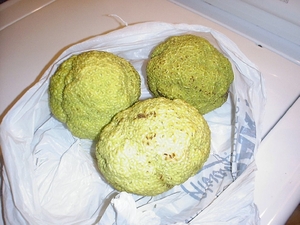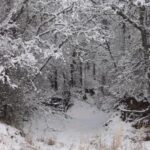Also known by it’s scientific name of “Maclura pomifera”, the Osage Orange tree was discovered by the explorers Lewis and Clark some two hundred years ago. At that time, the Osage Indians had already found that the wood of the tree was useful for making strong weapons such as bows. Since that time, many other uses have been discovered for the incredible Osage Orange tree.
You can easily recognize the incredible Osage Orange tree by its unusual appearance. This type of tree usually grows to be twenty to thirty feet high, although they can grow much taller. On the average, Osage Orange trees grow to be a foot or two in diameter, although they can grow to be six or seven feet around. Its bark is light orangish-brown in color, and its leaves are thick and shiny green.
Because of their long, sharp thorns, Osage Orange trees have been planted and used as fences to keep livestock from straying. The wood of this tree is excellent for making items that are subjected to the outdoor elements. Because,
the wood doesn’t rot or become infested with termites and other nuisances. And, when the yellow wood of Osage Orange trees is burned, it burns hot. In fact, it produces almost as many BTU’s as coal. If you want to see a gorgeous display of flames and sparks, burn some green Osage Orange wood in your fireplace.
You may know the bumpy fruit of the Osage Orange tree by one of its many nicknames including “Hedge Apple”, “Horse Apple”, “Mock Orange”, “Monkey Brain” or “Spider Ball. The wrinkled skin of its softball-sized fruit is light green in color, and it gives off an aroma that smells like an orange.
It’s long been said that placing the fruit of the incredible Osage Orange tree at the entry points of your basement in the Fall helps repel spiders and insects. Some people say this is just an Old Wive’s Tale. However, research has found that the fruit of the incredible Osage Orange does in fact contain a chemical known as “2,3,4,5-tetrahydroxystilbene. This chemical is effective in repelling spiders and insects. And, research performed by Dr. Joel Coats in the Department of Entomology at Iowa State University shows that the Osage Orange does in fact repel German cockroaches.
So, if you have a problem with spiders and insects infesting your basement come Fall, grab some Osage Orange balls and place them near the windows and doors. In a couple of months, when the fruit has turned brown, remove them from your basement.
In the November 2001 issue of the “Martha Stewart Living Magazine”, the queen of homemaking recommends using the fruit of the incredible Osage Orange tree as Fall decoration: put on a pair of protective gloves and simply slice the fruit up with a serrated knife. (The sticky, white juice inside may irritate your skin otherwise.) Then, wrap the slices around balls of aluminum foil and allow them to dry for several days. Once they’re completely dried, remove the foil balls and use the “flower-like” slices of Osage Orange as part of your Fall decorations.
Interesting enough, in Eureka, Kansas, they hold a “Hedge Ball Chucking” contest every year. The winner is the person who can throw a hedge apple by using a machine. The record so far is 2,094 feet. The fruit was thrown with an air cannon. The winner took home one thousand dollars cash.
And finally, if you can’t find an Osage Orange fruit in your locality, then perform a search on the Internet for “Osage Orange fruit” or “Hedge Apples. You can buy these incredible fruit online.




